The Nakanishi Prize, named after Japanese chemist Koji Nakanishi, is an award in chemistry given alternately by the Chemical Society of Japan and the American Chemical Society.
The Nakanishi Prize, named after Japanese chemist Koji Nakanishi, is an award in chemistry given alternately by the Chemical Society of Japan and the American Chemical Society.
"To recognize and stimulate significant work that extends chemical and spectroscopic methods to the study of important biological phenomena." [1]
In 1995, friends and colleagues of Nakanishi established the Nakanishi Prize. It was decided that the Chemical Society of Japan and the American Chemical Society would alternate years awarding the prize. There are two separate endowments for the prize for each society, but the prize is the same for both awards: a medallion in presentation box, $5,000 prize money, and $2,500 travel reimbursements.
Source: American Chemical Society
| Year | Recipient | Institution | Rationale | Awarded by |
|---|---|---|---|---|
| 1996 | Yoshimasa Hirata | Nagoya University | Chemical Society of Japan | |
| 1997 | Frank H. Westheimer | Harvard University | American Chemical Society | |
| 1998 | Albert J. Eschenmoser | ETH Zurich | Chemical Society of Japan | |
| 1999 | Jeremy R. Knowles | Harvard University | American Chemical Society | |
| 2000 | Satoshi Ōmura | Kitasato University | Chemical Society of Japan | |
| 2001 | John D. Roberts | California Institute of Technology | American Chemical Society | |
| 2002 | Sir Jack Baldwin | University of Oxford | Chemical Society of Japan | |
| 2003 | A. Ian Scott | Texas A&M University | American Chemical Society | |
| 2004 | Isao Kitagawa | Kyoritsu College of Pharmacy | Chemical Society of Japan | |
| 2005 | Stephen J. Benkovic | Pennsylvania State University | American Chemical Society | |
| 2006 | Takeshi Yasumoto | Tohoku University | For his "contribution to the chemistry of seafood poisonings and analytical study on dynamism of the causative toxic molecules among marine ecology" [2] | Chemical Society of Japan |
| 2007 | Hung-wen Liu | University of Texas at Austin | American Chemical Society | |
| 2008 | Michel Rohmer | Louis Pasteur University | Chemical Society of Japan | |
| 2009 | JoAnne Stubbe | Massachusetts Institute of Technology | For identifying the role of radical intermediates in ribonucleotide reductase functions | American Chemical Society |
| 2010 | Shosuke Yamamura | Keio University | Chemical Society of Japan | |
| 2011 | C. Dale Poulter | University of Utah | American Chemical Society | |
| 2012 | Daisuke Uemura | Kanagawa University | Chemical Society of Japan | |
| 2013 | Arthur G. Palmer III | Columbia University | American Chemical Society | |
| 2014 | Jerrold Meinwald | Cornell University | Chemical Society of Japan | |
| 2015 | Fred W. McLafferty | Cornell University | For developing “top-down proteomics” for characterizing a protein's sequence and modifications [3] | American Chemical Society |
| 2016 | Shoichi Kusumoto | Chemical Society of Japan | ||
| 2017 | Martin Gruebele | American Chemical Society | ||
| 2018 | Nobuyuki Harada | Tohoku University | Chemical Society of Japan | |
| 2019 | Lewis E. Kay | University of Toronto | American Chemical Society | |
| 2020 | Yoshito Kishi | Harvard University | Chemical Society of Japan | |
| 2021 | Mei Hong | Massachusetts Institute of Technology | American Chemical Society | |
| 2022 | Takenori Kusumi | Tokushima University | Chemical Society of Japan | |
| 2023 | Gilad Haran | Weizmann Institute of Science | American Chemical Society | |
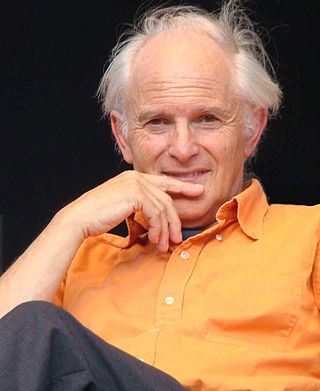
Sir Harold Walter Kroto was an English chemist. He shared the 1996 Nobel Prize in Chemistry with Robert Curl and Richard Smalley for their discovery of fullerenes. He was the recipient of many other honors and awards.
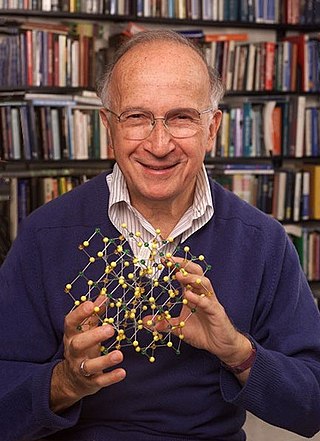
Roald Hoffmann is a Polish-American theoretical chemist who won the 1981 Nobel Prize in Chemistry. He has also published plays and poetry. He is the Frank H. T. Rhodes Professor of Humane Letters, emeritus, at Cornell University, in Ithaca, New York.
Jean M.J. Fréchet is a French-American chemist and professor emeritus at the University of California, Berkeley. He is best known for his work on polymers including polymer-supported chemistry, chemically amplified photoresists, dendrimers, macroporous separation media, and polymers for therapeutics. Ranked among the top 10 chemists in 2021, he has authored nearly 900 scientific paper and 200 patents including 96 US patents. His research areas include organic synthesis and polymer chemistry applied to nanoscience and nanotechnology with emphasis on the design, fundamental understanding, synthesis, and applications of functional macromolecules.

John Dombrowski Roberts was an American chemist. He made contributions to the integration of physical chemistry, spectroscopy, and organic chemistry for the understanding of chemical reaction rates. Another characteristic of Roberts' work was the early use of NMR, focusing on the concept of spin coupling.

Peter B. Dervan is the Bren Professor of Chemistry at the California Institute of Technology. The primary focus of his research is the development and study of small organic molecules that can sequence-specifically recognize DNA, a field in which he is an internationally recognized authority. The most important of these small molecules are pyrrole–imidazole polyamides. Dervan is credited with influencing "the course of research in organic chemistry through his studies at the interface of chemistry and biology" as a result of his work on "the chemical principles involved in sequence-specific recognition of double helical DNA". He is the recipient of many awards, including the National Medal of Science (2006).
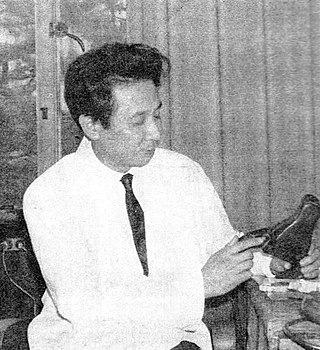
Koji Nakanishi was a Japanese chemist who studied bioorganic chemistry and natural products. He served as Centennial Professor of Chemistry and chair of the Chemistry Department at Columbia University.
The Arthur C. Cope Award is a prize awarded for achievement in the field of organic chemistry research. It is sponsored by the Arthur C. Cope Fund, and has been awarded annually since 1973 by the American Chemical Society. It consists of $25,000, a medallion, and $150,000 in funding for research in organic chemistry.
Fred Warren McLafferty was an American chemist known for his work in mass spectrometry. He is best known for the McLafferty rearrangement reaction that was observed with mass spectrometry. With Roland Gohlke, he pioneered the technique of gas chromatography–mass spectrometry. He is also known for electron-capture dissociation, a method of fragmenting gas-phase ions.

Omar M. Yaghi is the James and Neeltje Tretter Chair Professor of Chemistry at the University of California, Berkeley, an affiliate scientist at Lawrence Berkeley National Laboratory, the Founding Director of the Berkeley Global Science Institute, and an elected member of the US National Academy of Sciences as well as the German National Academy of Sciences Leopoldina.

JoAnne Stubbe is an American chemist best known for her work on ribonucleotide reductases, for which she was awarded the National Medal of Science in 2009. In 2017, she retired as a Professor of Chemistry and Biology at the Massachusetts Institute of Technology.
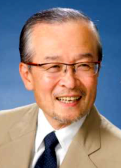
Hisashi Yamamoto is a prominent organic chemist and currently a member of the faculty at the University of Chicago and professor of Chubu University.
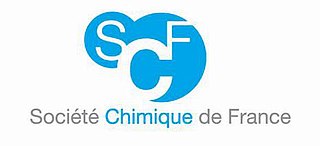
The Société Chimique de France (SCF) is a learned society and professional association founded in 1857 to represent the interests of French chemists in a variety of ways in local, national and international contexts. Until 2009 the organization was known as the Société Française de Chimie.

Jack H. Freed is an American chemist known for his pioneering work in electron paramagnetic resonance spectroscopy. He is the Frank and Robert Laughlin Professor of Physical Chemistry, emeritus, at Cornell University in Ithaca, New York.
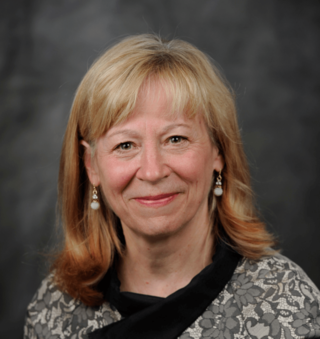
Geraldine Lee Richmond is an American chemist and physical chemist who is serving as the Under Secretary of Energy for Science in the US Department of Energy. Richmond was confirmed to her DOE role by the United States Senate on November 5, 2021. Richmond is the Presidential Chair in Science and professor of chemistry at the University of Oregon (UO). She conducts fundamental research to understand the chemistry and physics of complex surfaces and interfaces. These understandings are most relevant to energy production, atmospheric chemistry and remediation of the environment. Throughout her career she has worked to increase the number and success of women scientists in the U.S. and in many developing countries in Africa, Asia and South America. Richmond has served as president of the American Association for the Advancement of Science, and she received the 2013 National Medal of Science.

Jerrold Meinwald was an American chemist known for his work on chemical ecology, a field he co-founded with his colleague and friend Thomas Eisner. He was a Goldwin Smith Professor Emeritus of Chemistry at Cornell University. He was author or co-author of well over 400 scientific articles. His interest in chemistry was sparked by fireworks done with his friend Michael Cava when they were still in junior high school. Meinwald was also a music aficionado and studied flute with Marcel Moyse – the world's greatest flutist of his time.

Satoshi Ōmura is a Japanese biochemist. He is known for the discovery and development of hundreds of pharmaceuticals originally occurring in microorganisms. In 2015, he was awarded the Nobel Prize in Physiology or Medicine jointly with William C. Campbell for their role in the discovery of avermectins and ivermectin, the world's first endectocide and a safe and highly effective microfilaricide. It is believed that the large molecular size of ivermectin prevents it from crossing the blood/aqueous humour barrier, and renders the drug an important treatment of helminthically-derived blindness.
Yoshimasa Hirata was a Japanese organic chemist.
Alastair Ian Scott was a British-American organic chemist who achieved international renown for elucidating the biosynthetic pathway of vitamin B12.